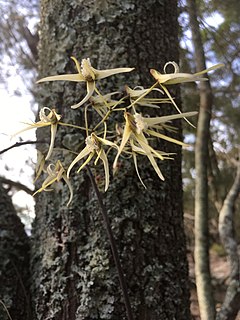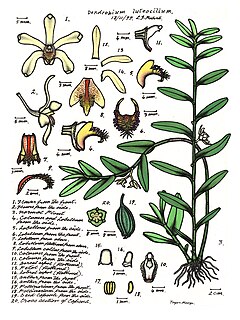Acriopsis emarginata, commonly known as the pale chandelier orchid, is a species of orchid endemic to Queensland. It is a clump-forming epiphyte with dark green leaves and curved, branching flower stems with many white and cream-coloured flowers.

Dendrobium teretifolium, commonly known as the thin pencil orchid, rat's tail orchid or bridal veil orchid, is an epiphytic or lithophytic orchid in the family Orchidaceae. It has long, thin hanging stems, pencil-like leaves and rigid flowering stems bearing up to twelve crowded white to cream-coloured flowers. It grows in rainforest and humid open forest mostly in near-coastal districts in New South Wales and Queensland.

Dendrobium antennatum, commonly known as the green antelope orchid, is an epiphytic orchid in the family Orchidaceae. It has cylindrical pseudobulbs with up to twelve leaves near their tips and up to fifteen white flowers with green petals and a white labellum with purple stripes. It grows in New Guinea and in tropical North Queensland where it is rare.

Dendrobium jonesii, commonly known as the oak orchid is a species of epiphytic or lithophytic orchid endemic to far north Queensland. It has spindle-shaped pseudobulbs, up to seven thin, dark green leaves and up to thirty five crowded, star-like, fragrant cream-coloured or white flowers with purple markings on the labellum.

Dendrobium linguiforme, commonly known as the thumbnail orchid, tick orchid or tongue orchid, is a plant in the orchid family Orchidaceae and is endemic to eastern Australia. It grows on trees or on rocks, with wiry, prostrate stems, prostrate, fleshy leaves and spikes of up to twenty white to cream-coloured flowers in early spring.

Dendrobium striolatum, commonly known as the streaked rock orchid is a species of orchid endemic to eastern Australia. It is a small, usually lithophytic orchid with wiry stems, cylindrical leaves and flowering stems with one or two yellow, cream-coloured or greenish flowers with reddish stripes. It often grows on cliff faces in New South Wales, Victoria and Tasmania.
Aerides inflexa is a species of orchid in the genus Aerides that was first described in 1862. It is native to Borneo and Sulawesi.

Dendrobium cucumerinum, commonly known as the cucumber orchid or gherkin orchid, is a species of orchid endemic to eastern Australia. It is an epiphytic orchid with creeping stems, gherkin-like leaves and flowering stems with up to eighteen cream-coloured, yellowish or greenish white flowers with purple stripes. It often grows on large trees near streams but is also found in drier forests.

Dendrobium pugioniforme, commonly known as the dagger orchid is a species of orchid endemic to eastern Australia. It is an epiphytic or lithophytic orchid with pendulous, wiry stems, fleshy, sharply pointed leaves and flowering stems with one or two greenish or yellowish flowers with a white labellum. It grows on trees and rocks, mostly in humid forest.

Dendrobium adae, commonly known as the slender cane orchid, is an epiphytic, sometimes lithophytic orchid in the family Orchidaceae. It has cylindrical pseudobulbs, up to four dark green leaves and up to six white or greenish to apricot-coloured flowers. It grows in tropical North Queensland, Australia.

Dendrobium schoeninum, commonly known as the common pencil orchid, is an epiphytic or sometimes a lithophytic orchid in the family Orchidaceae and has thin wiry, upright or pendent stems with fleshy, grooved, dark green leaves. Its short flowering stems have one or two, rarely up to four pale green, cream-coloured or mauve flowers with purple markings on the labellum. It grows on rainforest margins in coastal New South Wales and southern Queensland.

Dendrobium bowmanii, commonly known as the straggly pencil orchid, is an epiphytic or lithophytic orchid in the family Orchidaceae. It has thin wiry, straggly stems with a small number of small leaves and up to four greenish or brownish flowers with a conspicuous white labellum. It grows in drier rainforests and coastal scrub in New South Wales, southern Queensland and New Caledonia.
Dendrobium carrii, commonly known as the furrowed moon orchid, is an epiphytic orchid in the family Orchidaceae and has well-spaced pseudobulbs with one or two leaves, and flowering stems bearing between five and ten white or cream-coloured flowers with an orange or yellow labellum. It mostly occurs on the ranges inland from Cape Tribulation and Innisfail in Queensland.

Dendrobium finniganense, commonly known as the Mount Finnigan cane orchid, is a species of terrestrial or lithophytic orchid endemic to a few mountain tops in far north Queensland, Australia. It has narrow, cylindrical pseudobulbs, each with up to three thin, dark green leaves and usually only one or two white to cream-coloured flowers with yellow and purple markings near the centre.
Dendrobium litorale, commonly known as the coastal shaggy orchid, is an epiphytic orchid in the family Orchidaceae. It has a very short rhizome with crowded, slender stems with most of the leaves in the lower half. The leaves are flattened and pointed, the flowers small and pale greenish cream-coloured. It occurs on islands in the Torres Strait and in New Guinea.

Dendrobium pruinosum, commonly known as the honey orchid, is an epiphytic or lithophytic orchid in the family Orchidaceae and has flattened, yellowish stems and pairs of cream coloured, dull yellow or greenish flowers. It grows in tropical North Queensland and New Guinea.

Dendrobium toressae, commonly known as the sparkle orchid or mica orchid, is a species of epiphytic or lithophytic orchid with highly branched stems forming dense patches. The leaves are crowded, fleshy and dark green with a glittery surface. A single cream-coloured to pale pink flower with a yellow labellum develops in a leaf axil. It is endemic to tropical North Queensland.

Dendrobium tozerense, commonly known as the white gemini orchid, is an epiphytic or lithophytic orchid in the family Orchidaceae. It has thin, wiry stems, stiff leaves and pairs of star-shaped, white flowers. It grows in rainforest in tropical North Queensland, Australia.

Dendrobium malbrownii, commonly known as the McIlwraith hermit orchid, is an epiphytic or lithophytic orchid in the family Orchidaceae and is endemic to tropical North Queensland, Australia. It has thin, wiry, crowded stems each with narrow, dark green leaves and a single shiny, cream-coloured flower with a purple labellum. It grows on trees, fallen logs and rocks in rainforest on the McIlwraith Range.
Dendrobium coriaceum, commonly known as the inland rock orchid, is a species of lithophytic orchid that is endemic to North Queensland. It has tapered pseudobulbs, up to three thick, leathery leaves and up to forty yellow or cream-coloured flowers with purple markings on the labellum.















